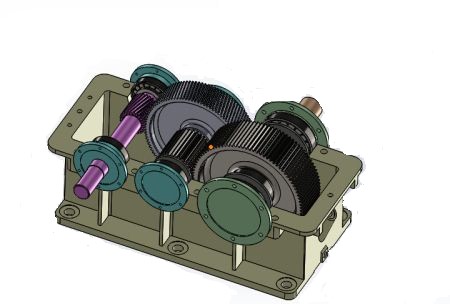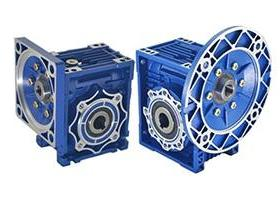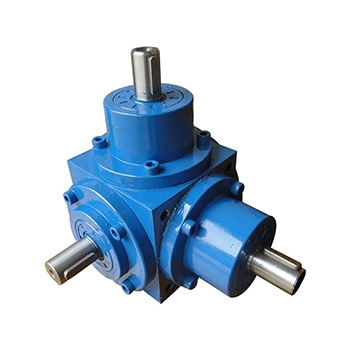What is a Speed Reducer?
Speed reducers, also referred to as gearboxes or gear reducers, are enclosed mechanical gadgets between a motor and a piece of machinery that utilize gear trains to increase torque and lower speeds on a drive. In general, a speed reducer is a housing that contains no less than two sets of gears (depending on ration desired), supporting bearings, shafts and seals for realizing gear, worm or gear-worm types of transmission, thus making it a very important part of mechanical power transmission systems.
How does it work?
A gear reducer is generally used for low-speed and high-torque transmission systems. The output gear of a speed reducer has more teeth than the input gear. So, while the output gear might rotate more slowly, reducing the speed of the input, the torque is increased. To sum up, the combination of large and small gears will reduce speed while increasing the torque.  The ratio of the number of rotations of a driver gear to the number of rotations of a driven gear is known as a gear ratio. By changing the torque/speed output, a machine (usually a motor or an engine) can be precisely controlled and better results attained. Torque output of a speed reducer can be calculated by multiplying the output torque of the motor and reduction ration (Note that the actual torque output of the speed reducer shall not exceed its rated torque). In decelerating the motor, gearboxes also reduce the reflected load inertia to the motor by a factor of the square of the gear ratio.
The ratio of the number of rotations of a driver gear to the number of rotations of a driven gear is known as a gear ratio. By changing the torque/speed output, a machine (usually a motor or an engine) can be precisely controlled and better results attained. Torque output of a speed reducer can be calculated by multiplying the output torque of the motor and reduction ration (Note that the actual torque output of the speed reducer shall not exceed its rated torque). In decelerating the motor, gearboxes also reduce the reflected load inertia to the motor by a factor of the square of the gear ratio.
Types of speed reducers
Different types of speed reducers deliver different functions and they can be classified in various manners. Based on the way that transmission is delivered , we have spur gears, gear boxes and planetary gear boxes. According to the number of transmission stages, there are single-stage and multi-stage speed reducers. As far as the gear shape is concerned, they can be divided into cylindrical gear reducers, bevel gear reducers and cone-cylindrical gear reducers. Different arrangements of transmission brings about expansion reducers, split reducers and coaxial reducers.
There are four common types of gearboxes among others: worm gears, planetary gears, spur gears, and bevel gear reducers.
Worm Gear Reducers
This right angle speed reducer combines a worm wheel which makes it possible to obtain a large reduction ratio of about 1/10 to 1/60.  Worm gear reducers are generally used for applications requiring very high gear ratios. They are constructed with perpendicular input and output shafts. The irreversible mechanism of worm reducers means that the snail cannot drive the worm, equipping them with a self-locking function and a higher level of system security. With low initial cost, high ratio and high output torque, worm gearboxes are perhaps the most cost-effective reduction solution.
Worm gear reducers are generally used for applications requiring very high gear ratios. They are constructed with perpendicular input and output shafts. The irreversible mechanism of worm reducers means that the snail cannot drive the worm, equipping them with a self-locking function and a higher level of system security. With low initial cost, high ratio and high output torque, worm gearboxes are perhaps the most cost-effective reduction solution.
Planetary Gear Reducers
Plenatary gear reducers offer many advantages such as compactness, low ground clearance, high efficiency, long service life, and large rated output torque. These gear reducers adopt coaxial assembly. Plenatary designs deliver unique combination of both compactness and outstanding power transmission efficiencies with typical efficiency losses only 3% per stage. This means that a high proportion of the input energy is multiplied and transmitted into torque, rather than being wasted on mechanical losses. On the other hand, the complex and expensive construction of planetary gearboxes require specialized maintenance.
Spur Gears
Gear reducers featuring a spur gear set boast the simplicity of its design and up to 50% more torque than planetary gearboxes. The straight transformation of torque and speed makes spur gear reducers quite efficient and ideal for high-speed applications. Given high transmission efficiency, low energy consumption and superior performance, they are considered the most common and preferable type across industries.
Bevel Gear Reducers
A bevel gear reducer has a much higher efficiency than the worm gear. It's suitable for applications that require a right angle speed reducer with a low ratio. Bevel gear reducers feature an angled bell crank allowing users to change the machine's rotation system from the lateral rotation system to the longitudinal rotation system.  Being compact and sturdy, bevel gears can handle high power. Applications that require high torque should consider utilizing a bevel gearbox. Gears with increased meshing ratio by twisting the tooth traces of bevel gears such as helical gears are called spiral bevel right angle gearboxes.
Being compact and sturdy, bevel gears can handle high power. Applications that require high torque should consider utilizing a bevel gearbox. Gears with increased meshing ratio by twisting the tooth traces of bevel gears such as helical gears are called spiral bevel right angle gearboxes.
Applications
Thanks to its compact structure, large range of power transmission, reliability, long life, high efficiency, simple use and maintenance, the speed reducer is widely used in various mechanical transmission systems as well as motion mechanisms from ships, automobiles, locomotives, heavy machinery used in construction, processing machinery and automated production equipment, to home appliances, clocks and watch, etc. Its applications cover reducer, food and light industry, electric machinery, construction machinery, metallurgical machinery, cement machinery, environmental protection machinery , Electronic appliances, road construction machinery, water conservancy machinery, chemical machinery, mining machinery, conveying machinery, building materials machinery, rubber machinery, petroleum machinery and other industries have strong demand for reducer products.
You can find many speed reducers on our site. Just head to our product section or check out our search function to find all related options. If you have any feedback regarding this article or other suggestions, please leave your comments below!

